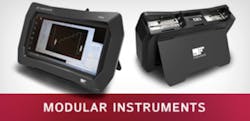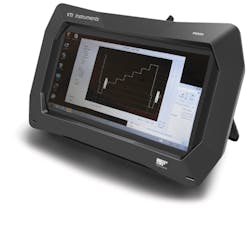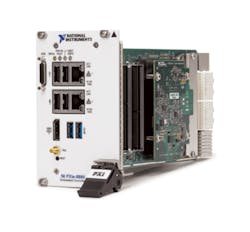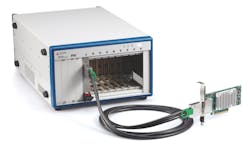Test-system functionality obviously depends on the hardware modules that have been provided. Using a DMM to make voltage measurements and a digitizer to measure and record waveforms are two of the more common implementations. However, the overall operation of the system is governed by the associated software, and for modular systems, the software runs on either an embedded or a remote controller.
Embedded
Among the reasons to choose an embedded controller are compact size, which can facilitate portability, and special features that may not be available in a standard PC. Keysight Technologies’ Andrew Smail, product and solutions marketing manager, software and modular solutions division, explained some of the advantages of the company’s M9037A embedded PXIe controller.
“The M9037A” he said, includes a high-performance, extended-life CPU. The controller [directly] supports connection to multichassis and RAID storage… without using high value instrument slots. The Intel i7 CPU’s Hyper Threading and multicore technology provides performance required for multithreaded applications. The CPU comes preloaded with the operating system, drivers, and Keysight IO libraries for reduced startup time.” He concluded, “The controller features a removable solid-state drive (SSD) that offers faster boot time and mechanical reliability. The SSD can be easily removed from the front panel and secured when not in use.”
With its PCIe four- or two-link (up to x24) configuration, the M9037A provides up to a 16-GB/s maximum bandwidth from the CPU to the PXIe backplane switch. IO connections on the front panel include two USB 3.0, four USB 2.0, two 10/100/1000 LAN, GPIB, two DisplayPort, and the PCIe x8 connection (vs. four USB 2.0, two LAN 10/100/1000, GPIB, and DVI-I connections in the previous generation controller).
Smail commented on the execution of further applications, in addition to RF measurements, that is significantly improved because of the Intel Quad-Core i7-4700EQ CPU running at 2.4 GHz in combination with Windows 7 and up to 16 GB of memory. “Measurement-intensive applications, such as power amplifier manufacturing test, benefit from the increased data throughput and computational speed of the latest controller. Other applications, such as monitoring of satellite signals, benefit from speed and multichassis improvements because multiple satellite channels can be monitored at once and multiple tests can be executed such as channel power monitoring and detailed modulation analysis. Support for multiple high-resolution displays is useful as well, allowing… different groups of measurements (for example, measurement type or channels) [to be] displayed on different monitors.”
ADLINK Technology makes several embedded controllers ranging from the PXI-3920 based on an Intel Pentium M 760 2.0 GHz processor to the newest PXIe-3985 with an Intel Core i7-4700EQ Quad-Core processor. As described on the company’s website, “…The PXIe-3985 utilizes four separate computing engines on a single processor, enabling execution of numerous independent tasks simultaneously in a multitasking environment. With a configurable PCIe switch, the [controller] can support four links x4 or two links x16 and x8 PXIe link capability, with maximum system throughput of up to 8 GB/s.”
In addition, according to the company, the controller provides “…two DisplayPort connectors, allowing connection to two monitors; dual USB 3.0 connections for high-speed peripheral devices; dual Gigabit Ethernet ports, with one for LAN connection and the other for controlling LXI instruments; four USB 2.0 ports for peripheral devices and USB instrument control; and a Micro-D GPIB connector for GPIB instrument connection, for hybrid PXI-based testing systems control.”
Tom Sarfi, vice president product management at VTI Instruments, described the company’s Model PMX04 four-slot PXI-hybrid mainframe with an embedded 1.7-GHz Intel Core i7-based controller (Figure 1). He said, “There also is an integrated touch screen that runs Windows 8.1. With the touch screen and the capability to host turnkey software applications like X-Modal, this product is best suited for the portable data acquisition market.
Courtesy of VTI Instruments
[As an example,] “a large avionics customer recently selected the PMX04 for structural dynamics applications,” Sarfi continued. “The company had already standardized on VTI’s PXI Express digitizer modules for dynamic signal testing and added the PMX04 to its facility to provide technicians the ability to carry around a portable chassis with 48 channels of digitizers (with turnkey software) and quickly setup and take data in the field.”
The 16.5-inch x 2.6-inch x 11.2-inch, 15-lb unit boasts a 14-inch 1,366 x 768 pixel LCD display with tempered glass for protection and an LED backlight and an Intel QM67 PCH chipset to match the Core i7 CPU. The capacitive touch screen recognizes up to five points in multitouch applications. As well as a 10-MHz clock input, IO includes three USB 2.0, one RJ-45 Ethernet, three eSATA, one HDMI, and a synchronous trigger connection.
Adam Foster, product marketing manager-test and RF at National Instruments, described the latest addition to the company’s range of more than 20 embedded PXI/PXIe controllers based on Intel Core, Dual-Core, Quad-Core, Xeon, Celeron, and Atom processors. The large number of individual units results from having PXI or PXIe versions with or without LabVIEW Real-Time for about nine base units.
Foster said, “NI’s new PXIe-8880 (Figure 2) brings the power of Intel Xeon workstation CPUs to test engineering applications. The eight-core processing power of Intel Xeon and PCIe Gen III technology give engineers twice the bandwidth performance and three times the processing power, making it a future-proof, zero-compromise investment for any test or measurement application.”
Courtesy of National Instruments
He continued, “This embedded PXIe controller is [especially useful] for high-performance, high-throughput, and computationally intensive test and measurement applications such as 5G cellular research, semiconductor production test, and RF record and playback as well as any application where test time and time-to-market are of importance. Additionally, this embedded controller is particularly useful when paired with system design software that is optimized for parallel processing such as NI LabVIEW due to the multicore nature of the CPU.
“The new PXIe-8880 is based on the Intel XeonE5 processor; features eight cores, a 2.3-GHz base frequency, and up to 3.4 GHz single-core turbo frequency; and can sustain 24-GB/s data throughput…,” Foster concluded.
According to the NI website, “LabVIEW Real-Time applications running on PXI systems achieve millisecond loop rates with only 3 µs to 4 µs of system jitter. These real-time measurement and control systems capitalize on Intel processors combined with the advanced timing, triggering, and I/O synchronization benefits of PXI. Furthermore, NI measurement services software extends the timing capabilities of PXI to deliver tight integration with LabVIEW Real-Time applications through operations such as hardware-timed software loops.”
Remote
The most common remote-controller technology allows you to link a PC to your test system, using the PC as the controller. Although embedded controllers facilitate compact test systems, they have a number of often-cited drawbacks, as described by Pickering Interfaces’ David Owen, business development manager at the company. He said, “Embedded controllers provide the most compact solution but are often not the latest generation of processors, which tend to arrive first on desktops. Remote controllers also are the lowest cost as they are in an intensively competitive business. So cost, compactness, and performance are primary factors. [You] also need to consider if there are any issues [in] attaching to a network, [as] all PCs on a network are of interest to the IT department and their management (virus checking, security patches, operating system updates). The use of a desktop PC solves [many] of these issues.”
Owen continued, “The key issue with any remote PC interface is transparency, noticeable by the fact it is not noticeable. If it works well, the PXI chassis is merely an extension of the desktop PC. They should not affect operation as the bus speeds are fixed, unlike the processor architecture.” He concluded, “Most interfaces are not data intensive. Most test systems are controller limited rather than backplane/interface limited.”
Owen said that remote interfaces are used for a variety of reasons. These include the use of PCI/PCIe modules in test that may not be available in PXI, access to more external ports than may be on an embedded controller, and cost. A desktop PC and remote PC interface often are lower in cost than an embedded solution.
Pickering’s Model 41-924 PCIe-to-PXI remote control interface uses a single-lane PCIe connection to provide a seamless connection between a PC’s PCIe slot and a PXI chassis. PXI 32-bit bus speeds of 33 MHz to 66 MHz are supported. The 41-924 kit includes both the 51-924 PCIe card that is inserted in the PC and a 41-924 PXI module that mounts in slot 1 of the PXI chassis. A 3-meter lead connects the two devices.
ADLINK also provides remote controllers, the most recent being the PCIe-PXIe-8638 (Figure 3), which has sustained throughput of 4 GB/s in each direction, even when the PC and PXIe chassis are separated by up to 5 meters. As described in the EE-Evaluation Engineering newsletter on Sept. 16, 2014, “Fully software- and driver-transparent bandwidth up to 4 GB/s is available through PCIe Gen 2 x8 link capability. With the PCIe-PXIe-8638, processor performance is maximized for an industrial PC, server, or workstation, delivering dependable remote control of the PXI/PXIe system, maximum flexibility, and reduced hybrid-test application costs.”
Courtesy of ADLINK Technology
NI has nine products that facilitate remote control, including rack-mount 1U controllers, ExpressCard links for use with laptop computers, and MXI-based desktop PC links. The NI PXIe-PCIe-8381 MXI-Express for PXIe kit features a fully transparent, high-bandwidth, cabled PCIe link for which all PXI and PXIe modules appear as PCI boards within the computer itself. The NI PXIe-PCIe-8381 uses an x8 cabled PCIe 2.0 link to connect a PXIe chassis to desktop PCs. This kit includes an NI PCIe-8381 board in the PC that is connected via a x8 Gen 2 cabled PCIe copper cable to an NI PXIe-8381 module in slot 1 of a PXIe chassis. The NI PXIe-8384 supports multichassis expansion.
The NI PCIe/PXIe-8375 kit provides an MXI-Express x4 PXIe link that allows up to 100 meters of fiber-optic cable between an NI, Dell, or HP desktop computer, server, or workstation and a PXIe chassis. The PCIe-8375 card fits in the PC, and the PXIe-8375 card goes in slot 1 of the PXIe chassis. NI’s PCIe-8371 and PXIe-8370 modules are similar to the 8375 but with copper cabling instead of fiber optic. The 8360 series of modules also provides MXI Express x4 links, but to PXI rather than PXIe systems. PXI link maximum speed is approximately 100 MB/s, increasing to about 830 MB/s for PXIe.
VTI’s Sarfi discussed the LXI-PXIe remote interface that the company introduced a few years ago. He said, “This is a module that plugs into the controller slot of a PXIe chassis and provides a remote interface between VTI’s PXIe modules and a host controller. These interfaces allow separation of the host and PXIe chassis that is virtually limitless. This interface is popular in mechanical test applications where multiple PXIe mainframes are distributed across a test article. The Ethernet interface allows the PXIe modules to be placed close to the device being tested, greatly reducing the length of sensor cable required.
“The challenge with distributing mainframes is maintaining synchronization between measurements,” he continued. “We incorporated IEEE 1588 to ensure that the measurements in multiple mainframes are tightly synchronized. [Because] the PXI standard and PXI module drivers do not anticipate a remote communications interface between the PXI chassis and the host controller, the VTI EMX-2500 currently only supports communication to VTI PXI Express modules.”
A VTI press release details how this type of interface was employed by Virginia Tech in its Smart Infrastructure Lab. According to the release, “Goodwin Hall is the most instrumented building in the world with more than 240 accelerometers distributed throughout the building. The facility will be extremely valuable in the improvement of research in fields including structural health monitoring, building dynamics, foot-pattern tracking, behavioral science, and smart energy usage.
“By incorporating the VTI CMX09 PXIe chassis, the EMX-4250 PXIe DSA, and the EMX-2500 PXIe LXI Ethernet controller, Virginia Tech was able to create a 288-channel modular, scalable DAQ solution distributed throughout the building on multiple floors. VTI’s incorporation of the IEEE 1588 Precision Time Protocol via Ethernet allowed easy synchronization with no additional synchronization cabling required. With all channels synchronized, dynamic events can be tracked [and] analyzed, and phasing can be maintained for modal analysis.”1
Keysight’s M9037A controller, although embedded, also features a remote capability. The company’s Smail commented, “The M9037A has a remote interface that is especially useful in applications that require both AXIe and PXIe chassis. One such application is active array antenna calibration. In this case, a PXIe chassis is used for down conversion and signal-conditioning modules, and an AXIe chassis is used with multiple phase-coherent digitizers. The embedded controller interfaces to both chassis: direct access to the PXIe chassis and remote access to the AXIe chassis.”
Summary
When you deliver your next PXI/PXIe/AXIe test system late and over budget, don’t blame it on lack of a suitable controller. With embedded models based on Intel processors ranging from Atom to Xeon, almost any level of performance is available—at a price. Just considering NI embedded controllers, the price ratio between the low-end Atom and high-end Xeon models is about 7:1.
For remote controller applications, you also have a choice of performance in the PCIe-PXI/PXIe link. Here, it may make sense to buy a high-capacity link so that if a future test-system upgrade demands a faster PC, the link won’t suddenly become a communications bottleneck.
Reference
- “Virginia Tech Partners with VTI Instruments to advance education and research in infrastructure monitoring,” VTI Instruments, November, 2014.




